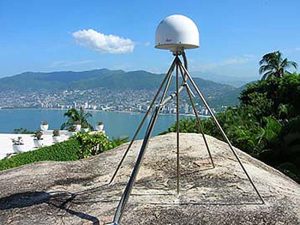
Credit: NathalieCotte / CNRS.
In subduction zones, where one tectonic plate slides beneath another, slow, imperceptible slip, known as ‘slow earthquakes’ or ‘slow slip events’, can trigger powerful quakes a little further away. This has just been shown by researchers from CNRS, Université Grenoble Alpes and IRD, in collaboration with colleagues at the National Autonomous University of Mexico. Their paper is published in the journal Nature Geoscience on 3 october 2016.
Discovered twenty years ago, slow earthquakes are imperceptible slip events that last several weeks or months, do not generate seismic waves and cause no damage. However, they can release as much energy as a magnitude 7.5 earthquake. Understanding such slow slip events and their relationship to ordinary earthquakes is therefore of fundamental importance in better assessing seismic risk. Now, researchers have for the first time shown that a slow slip event can trigger a conventional earthquake. Researchers at the Institut des Sciences de la Terre (CNRS/Université Grenoble Alpes/IRD/Université Savoie Mont Blanc/IFSTTAR), together with colleagues from the National Autonomous University of Mexico, have shown that the magnitude 7.3 quake that struck Papanoa on 18 April 2014 was caused by a slow slip event that had begun two months earlier in the region of Acapulco in the Mexican state of Guerrero.
The geophysicists who made the discovery have been working for many years in this coastal region, where the oceanic Cocos plate slides beneath the North American plate. This phenomenon, known as subduction, is usually accompanied by earthquakes, since rather than sliding past each other seamlessly, the two plates deform and build up energy which is then released, causing the quakes. However, the area under study has not experienced any major quakes since 1912, and is thus known as a ‘seismic gap’. In addition, the installation of permanent GPS stations from 1997 onwards made it possible to detect slow earthquakes: although the Cocos and North American plates are converging at a speed of 5-6 cm/yr, every four years the gap zone experiences six-month-long periods when slip occurs in the opposite direction, with displacements reaching 15 cm.
By studying the GPS data, the researchers showed that, in the Guerrero seismic gap, slow slip events release part of the accumulated strain, making a major earthquake less likely. However, the slow slip event initiated in February 2014 transferred strain to a neighboring, seismogenic region, triggering a magnitude 7.3 earthquake on 18 April 2014 near the town of Papanoa.
This study enhances understanding of the relationship between slow slip events and conventional earthquakes in a subduction zone. The research has major societal implications, since around 20 million people would be directly affected by the devastating impact of a major earthquake on Mexico’s Pacific seaboard. The study shows that there is a greater risk of earthquakes during slow slip episodes. More generally, it highlights the importance of studying deformation signals in the days and weeks preceding major quakes. Consolidating networks of permanent GPS stations, as well as developing GPS networks on the seabed in the vicinity of areas where earthquakes initiate, will in the future make for increasingly accurate detection of the characteristics of slow slip events that may precede ordinary quakes.
Reference:
M. Radiguet et al. Triggering of the 2014 Mw7.3 Papanoa earthquake by a slow slip event in Guerrero, Mexico, Nature Geoscience (2016). DOI: 10.1038/ngeo2817
Note: The above post is reprinted from materials provided by CNRS.










